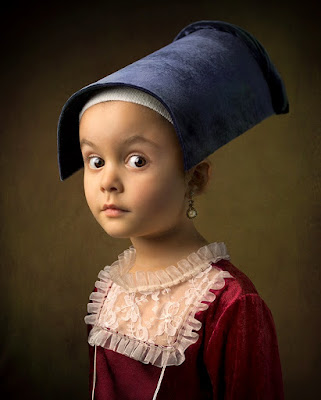LIFE IMITATES ART II
As I was surfing the Internet, I came across this famous painting of a Dutch girl by Johannes Vermeer. What caught my attention in particular—having already become acquainted with this painting—was another picture juxtaposed with it. My reaction was like,”Oh my, that’s just like my series from last year, ‘Life Imitates Art.’” True to my nature, I became totally engrossed in the idea of finding possible other similar depictions. To my delight, the research proved almost overwhelmingly fruitful.
 |
| Johannes Vermeer (1632-1675) |
But first, let me say something about the author of the original. Johannes Vermeer (1632 – December 1675) was a Dutch artist who specialized in domestic interior scenes of middle-class life. Vermeer was a moderately successful provincial genre painter in his lifetime. He evidently was not wealthy, leaving his wife and children in debt at his death, perhaps because he produced relatively few paintings.
Vermeer worked slowly and with great care, and frequently used very expensive pigments. He is particularly renowned for his masterly treatment and use of light in his work.
Almost all his paintings are apparently set in two smallish rooms in his house in Delft; they show the same furniture and decorations in various arrangements and they often portray the same people, mostly women.
Perhaps the best-known of Vermeer’s works is his Girl with a Pearl Earring (Meisje met de parel). It is an oil painting of a girl with a head scarf and a pearl earring. It depicts a Dutch girl wearing an exotic dress, an oriental turban, and an improbably large pearl earring.The estimated date of the painting is around 1665. Its size is rather small, 17” high and 15.5” wide.
In 2014, Dutch astrophysicist Vincent Icke raised doubts about the material of the earring and argued that it looks more like polished tin than pearl on the grounds of the specular reflection, the pear shape and the large size of the earring.
After the most recent restoration of the painting in 1994, the subtle color scheme and the intimacy of the girl's gaze toward the viewer have been greatly enhanced. During the restoration, it was discovered that the dark background, today somewhat mottled, was initially intended by the painter to be a deep enamel-like green. This effect was produced by applying a thin transparent layer of paint, called a glaze, over the present-day black background. However, the two organic pigments of the green glaze, indigo and weld have faded. (Source: Wikipedia)
I had no idea how much the painting has inspired other depictions, either merely imitating, or spoofing the master. Some are in the “true” vein of “Life Imitates Art” with photographs of live models; others are imitation paintings or satiric renditions.
I was not so much interested in the source of the depictions as their varieties. These are just a few of the ones I liked. I call the collection "Girls with Pearl Earrings."
Other types of imitations are also kind of fun and interesting, though some spoofs in my opinion have crossed over to the side of irreverance towards great art; they will remain unexplored in this write-up. But I will include these cute dolls that were inspired by Vermeer's art.
And to finish up, this is the best of them all:







No comments:
Post a Comment